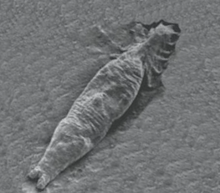Gyrodactylus salaris
| Gyrodactylus salaris | |
|---|---|

| |
| Scientific classification | |
| Domain: | Eukaryota |
| Kingdom: | Animalia |
| Phylum: | Platyhelminthes |
| Class: | Monogenea |
| Order: | Gyrodactylidea |
| Family: | Gyrodactylidae |
| Genus: | Gyrodactylus |
| Species: | G. salaris
|
| Binomial name | |
| Gyrodactylus salaris Malmberg,1957
| |

Gyrodactylus salaris,commonly known assalmon fluke,[1]salmon killer,or theNorwegian salmon killeris a tinymonogeneanectoparasitewhich lives on the body surface of freshwater fish.[2]This leech-like parasite has been implicated in the reduction ofAtlantic salmonpopulations in theNorwegian fjords.[3]It also parasitises other species, includingrainbow trout.[4]G. salarisrequiresfresh water,[2]but can survive inbrackish waterfor up to 18 hours.[5]
The parasite is 0.5 mm (0.02 in) long,[2]and cannot be seen with the naked eye, but it can be seen with amagnifying glass.[6]On itsposteriorend is ahaptor,a specialized organ for attaching to the host fish, which has sixteen hooks around its edge.[2]The parasite isviviparous,that is, it produces live offspring.[7] The parasites give birth to live young nearly as big as themselves and at this time, a further generation is already growing inside the neonates.[4]
Interactions with host fish
[edit]When feeding, the parasite attaches its anterior end to the fish with cephalic glands. It everts itspharynxthrough the mouth and releases a digestive solution withproteolytic enzymeswhich dissolves the salmon skin.Mucusand dissolved skin are then sucked into the gut. Attachment of many parasites can cause large wounds, damaging the epidermis of the host fish, which allows secondary infections.[4]
History
[edit]G. salariswas first described in 1952,[8]after being removed from a Baltic strain[2]of Atlantic salmon kept at the Hölle Laboratory in Sweden, near to the river Indalsälv.[8]At the time, it was not thought to cause disease in the host fish.[8]The presence ofG. salarison fish became aWorld Organisation for Animal Healthnotifiable disease in 1983.[8]
Catastrophic losses of Atlantic salmon occurred in Norway in the 1970s following the introduction ofG. salaris.By 2001, the salmon populations of 41 Norwegian rivers had been virtually wiped out in this way.[4]
Historically,Gyrodactylus-infected rivers have been treated with the indiscriminate pesticide/pisciciderotenone.A newer method of treatment employs dosing small volumes of aqueousaluminiumandsulfuric acidinto the river. A huge advantage of this method is its ability to kill the parasites without harming the hosts. This new method has shown promising results inBatnfjordelvaand Lærdalselva, two rivers inNorway.[9]
References
[edit]- ^Minchin, Dan (7 January 2008)."Gyrodactylus salaris"(PDF).DASIE: Delivering Alien Invasive Species Inventories for Europe. Archived fromthe original(PDF)on 24 December 2017.Retrieved2017-11-05.
- ^abcdeCain, Kenneth D.; Polinski, Mark P. (2014). "Chapter 3. Infectious diseases of coldwater fish in fresh water. Gyrodactylosis". In Woo, Patrick T.K.; Bruno, David W. (eds.).Diseases and disorders of finfish in cage culture(2nd ed.). CABI. pp. 95–96.ISBN9781780642079.
- ^C.Michael Hogan. 2011.Norwegian Sea.Encyclopedia of Earth. Eds. P.Saundry & C.J.Cleveland. National Council for Science and the Environment. Washington DC
- ^abcd"Notifiable diseases:Gyrodactylus salaris".Scottish Government. 8 December 2009.Retrieved2017-11-05.
- ^Hopkins, CCE (2002). "Introduced marine organisms in Norwegian waters, including Svalbard. Parasites and diseases". In Leppäkoski, Erkki; Gollasch, Stephan; Olenin, Sergej (eds.).Invasive Aquatic Species of Europe. Distribution, Impacts and Management.Dordrecht: Springer Netherlands. pp. 251–252.ISBN9789401599566.
- ^"Do not spread salmon parasiteGyrodactylus salaris"(PDF).Finnish Ministry of Agriculture and Forestry. Archived fromthe original(PDF)on 30 August 2005.Retrieved11 November2010.
- ^Shoemaker, Craig; Xu, De-Hai; LaFrentz, Benjamin; LaPatra, Scott (2015). "Chapter 1: Overview of fish immune system and infectious diseases. Monogenetic trematodes". In Lee, Cheng-Sheng; Lim, Chhorn; Gatlin, Delbert M. III; Webster, Carl D. (eds.).Dietary Nutrients, Additives, and Fish Health.Wiley-Blackwell. p. 16.ISBN978-0-470-96288-6.
- ^abcdHarris, Phil D.; Bachmann, Lutz; Bakke, Tor A. (2011). "The parasites and pathogens of the Atlantic salmon: Lessons fromGyrodactylus salaris".In Aas, Øystein; Klemetsen, Anders; Einum, Sigurd; Skurdal, Jostein (eds.).Atlantic Salmon Ecology.John Wiley & Sons. pp. 221–244.ISBN9781444348194.
- ^Robinson JV, James AL (1975)."Some observations on the effects produced in white mice following the injection of certain suspensions of corroding bacilli".Br J Exp Pathol.56(1): 14–6.PMC2072709.PMID1080.

